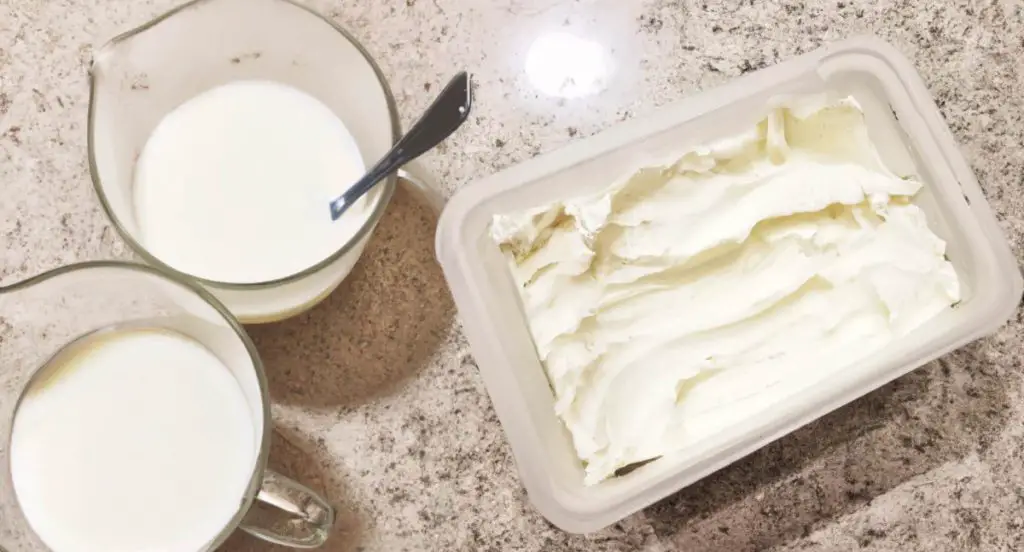Last Updated on May 26, 2023 by Aaron
Did you know that the United States is the highest producer of cheese, producing 6.856 million short tons per year? Now that’s a lot of cheese!
But, is cream cheese one of those? While it may not fit the traditional definition of cheese, cream cheese is a type of fresh cheese product that offers a unique and versatile addition to a variety of dishes.
So, grab a bagel and your favorite spread, and let’s dive in!
Table of Contents
What Makes a Cheese, a Cheese?
Cheese is a dairy product derived from milk and produced in a wide range of flavors, textures, and forms by coagulation of milk protein casein. It comprises proteins and fat from milk, usually the milk of cows, buffalo, goats, or sheep.
Now, back to our original question: Is cream cheese real cheese?
Technically, yes, cream cheese is a type of cheese, but it’s not like the traditional, aged cheeses like brie or cheddar which most people think of when they hear the word “cheese”. Cream cheese is classified as a fresh cheese, and it’s made differently than aged cheeses.
It’s also consumed differently and has a slightly different nutritional profile. Cream cheese is made from milk and cream and is meant to be consumed fresh. No aging required.
It has a mild, sweet taste with a pleasant slight tang. Cream cheese is known for its smooth and creamy texture, which makes it a popular spread for bagels and a key ingredient in recipes like cheesecake.
The Making Process of Cream Cheese
There are a few ways of making cream cheese. It can be done easily at home using a few simple ingredients or carried out on a large commercial scale.
However, the difference in taste and texture between homemade and commercial cream cheese can be significant. Homemade cream cheese often has a fresher, more tangy flavor and a less smooth texture compared to commercial cream cheese.
This is due to the absence of additives and stabilizers (gums) that are commonly used in commercial cream cheese to extend shelf life and create a uniform texture.
Some of the cream cheese brands that did not use gums are Green Valley and Sierra Nevada cream cheese USDA.
Most others contain gums as stabilizers, including Philadelphia cream cheese. If you are thinking about making cream cheese at home without gum, it is possible, but do consider that the moisture content will be much higher than the commercial one. Also, the quality (texture) will not be as smooth and may feel grainier. And it will likely spoil faster.
Homemade Cream Cheese
For homemade cream cheese, the ingredients and process are typically simpler.
A common recipe involves using milk, a starter culture (like yogurt or another source of lactic acid bacteria), or a coagulant like lemon juice, citric acid, and vinegar.
The milk is heated, the starter culture or coagulant is added, and the mixture is left to curdle. The curdled milk is then strained to remove the whey, leaving behind the cream cheese.
The fermentation process thickens the mixture and gives it a tangy flavor.
Preferably, instead of adding acid, you can add mesophilic starter cultures. The lactic acid-producing bacteria will sour the milk naturally. You can let the milk sit for 12-16 hours overnight at ~70°F. If you want a faster result in just 4-6 hours, just bring up the temperature to about 88°F.

To yield one container of cream cheese (about 8 ounces or 227 grams), approximately 2 quarts (about 1.9 liters) of milk are needed. This quantity can vary depending on the specific recipe and process used.
Commercial / Larger-scale production
here’s a simplified step-by-step breakdown of cream cheese production (1, 2):
- Standardize the milk: Blend raw milk with cream to achieve a final concentration of 12.3% fat and 3.4% protein.
- Homogenize and pasteurize the milk: This process is typically done at 14 MPa 55°C and 72°C for 15 seconds, respectively.
- Acidify the milk: Add 0.3% of frozen mesophilic starter culture to the milk and heat it to 31°C.
- Ferment the milk: Incubate the cultured milk at 31°C until it reaches a pH of 4.5. This fermentation forms an acidified milk gel.
- Heat treat the gel: This step reduces the activity of the starter culture and prepares the gel for whey separation.
- Separate the whey: This can be done using either centrifugation or the cloth bag method. Centrifugation typically results in less fat loss.
- Add gums and salt: After the whey has been separated, the curd is pumped to a hopper where gums and salt are added.
- Shear the mixture: The mixture is then sheared in a kettle.
- Package the cream cheese: The final product is hot-filled into the packaging.
The production of cream cheese starts with the homogenization and pasteurization of standardized milk, followed by acidification with lactic acid bacteria. This fermentation leads to coagulation, where the milk protein aggregates to form a continuous protein network, commonly referred to as an acidified milk gel.
This gel is then subjected to heat treatment, which reduces the activity of the starter culture.
The heat treatment applied to inactivate the starter culture also affects whey separation during centrifugation. Heat treatment can also denature whey proteins, altering interactions with casein proteins.
The continuous centrifugal separation employed at the industrial scale ensures sufficient whey is removed to achieve a standard cream cheese moisture content of ~50-54% w/w. Such centrifugal separation allows for a faster continuous process, compared to traditional batch processing using cloth bags, allowing the hot sample to be pumped to a hopper where gums and salt are added, followed by shearing in a kettle and hot filling into packaging.

Different Types and Varieties of Cream Cheese
The very first official cream cheese originated in the United States around 1873 when William A. Lawrence, a dairyman in Chester, New York, was the first to mass-produce an unripened fresh cheese known generically as cream cheese.
By adding cream to the process, he developed a richer cheese that he called “cream cheese”. In 1877, Lawrence created the first brand of cream cheese, and by the end of 1880, the cheese was being sold under the “Philadelphia” brand name.
Today, here are some of the most popular varieties you can find:
- Regular Cream Cheese: This is the most common type of cream cheese, known for its creamy texture and mild, slightly tangy flavor. It’s versatile and can be used in both sweet and savory dishes.
- Whipped Cream Cheese: This type of cream cheese has been whipped to incorporate air, making it lighter and fluffier than regular cream cheese. It’s easier to spread, making it a popular choice for bagels and sandwiches.
- Neufchâtel: This is a French cheese that is similar to cream cheese but made with whole milk rather than cream, resulting in a lower fat content. In the United States, Neufchâtel is often marketed as a lower-fat alternative to cream cheese. Read the comparison here.
- Low-Fat or Light Cream Cheese: This variety has less fat than regular cream cheese. It’s a popular choice for those watching their fat intake, but keep in mind that it may not have the same rich flavor and creamy texture as full-fat cream cheese.
- Non-Dairy Cream Cheese: Made from plant-based ingredients like soy or nuts, this type of cream cheese is a great option for those who are lactose intolerant or following a vegan diet. Read more.
- Flavored Cream Cheese: Cream cheese can be mixed with a variety of flavors, from sweet to savory. Some popular flavors include strawberry, blueberry, chive and onion, and smoked salmon.
- Double or Triple Cream Cheese: These types of cream cheese have a higher fat content due to the addition of extra cream. They are incredibly rich and creamy.
- Mascarpone: While technically a different type of cheese, mascarpone is often compared to cream cheese due to its similar texture and flavor. It’s a key ingredient in Italian desserts like tiramisu.
Cream Cheese vs. Other Cheeses
Cream cheese is a unique type of cheese that differs from others in several ways. Here’s a comparison of cream cheese with other popular types of cheese:
- Production Process: Unlike hard cheeses that are aged, cream cheese is not, resulting in a milder flavor. It’s a fresh cheese that’s meant to be consumed as soon as possible. The production process involves the addition of a starter culture to a milk and cream mixture, which helps ferment the lactose into lactic acid. This fermentation process thickens the mixture and gives it a tangy flavor. The mixture is then heated and curdled, and the curds are drained of whey but not pressed, resulting in a moist, spreadable texture.
- Texture: Cream cheese is known for its smooth, creamy texture, which is quite different from the firm texture of cheeses like cheddar or the crumbly texture of feta. This texture makes cream cheese ideal for spreading on bagels or mixing into recipes.
- Flavor: Cream cheese has a mild, slightly tangy flavor. This is in contrast to cheeses like blue cheese, which has a strong, pungent flavor, or gouda, which has a sweet, nutty flavor.
- Fat Content: Cream cheese has a higher fat content than many other kinds of cheese, contributing to its creamy texture. However, it’s worth noting that the fat content can vary depending on the specific brand and type of cream cheese.
- Uses: Cream cheese is incredibly versatile and can be used in a variety of dishes. It’s commonly spread on bagels, used as a dip for fruit and vegetables, and is a key ingredient in many desserts, including cheesecake and frosting for carrot cake. This is quite different from other cheeses, which might be used in sandwiches, salads, or melted on top of dishes.
- Nutritional Content: Cream cheese is high in fat and provides a good amount of vitamin A. However, it’s low in protein compared to other cheeses and does not offer the same range of nutrients.
How do you use cream cheese?
Cream cheese is a versatile ingredient that can be used in a variety of dishes, both sweet and savory. Here are some ways you can use cream cheese:
- Spread on Bagels or Toast: One of the most common uses for cream cheese is as a spread on bagels or toast. It’s a delicious way to start the day!
- Dips: Cream cheese can be used as a base for a variety of dips. For example, you can mix it with salsa for a quick and easy dip, or blend it with herbs and spices for a flavorful spread.
- Cheesecake: Cream cheese is a key ingredient in cheesecake, lending its creamy texture and tangy flavor to this popular dessert.
- Frosting: Cream cheese frosting is a favorite for carrot cake, red velvet cake, and many other types of cake. It’s easy to make by beating together cream cheese, butter, powdered sugar, and vanilla extract.
- Pasta Sauce: Cream cheese can be used to make a rich and creamy pasta sauce. Simply melt it together with a bit of milk or cream, then toss it with your favorite pasta.
- Stuffed Chicken or Peppers: Cream cheese can be used as a filling for dishes like stuffed chicken breasts or stuffed bell peppers. It adds a creamy texture and rich flavor.
- Mashed Potatoes: Adding cream cheese to mashed potatoes makes them extra creamy and delicious.
- Sushi: In some types of sushi, like the Philadelphia roll, cream cheese is used as one of the fillings.
- Baking: Cream cheese can be used in a variety of baked goods, from cookies and brownies to muffins and pastries.
- Soups and Chowders: Adding a bit of cream cheese to soups and chowders can give them a rich, creamy texture.

